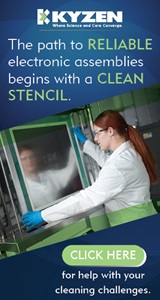|

|
|
| Ask the Experts | |||||||
|
|||||||
|
September 4, 2007 - Updated September 4, 2007 - Originally Posted Deflux Eutectic and Lead-Free AssembliesIs there a process that will allow us to deflux Eutectic and Lead-Free assemblies in a single cleaning process? P. B. |
|||||||
| Expert Panel Responses | |||||||
|
The correct answer is Yes and No. Technically speaking, both lead and lead-free flux residues may me cleaned at the same time, in the same machine. There are no valid concerns about "cross contamination" of lead onto lead-free assemblies. Contrary to "urban legends", a defluxing process, when using modern defluxing chemical additives, does not remove lead from eutectic assemblies and therefore, can not deposit lead onto lead-free assemblies. If you are considering a combined defluxing process, there are a couple of specific considerations that should be noted. Lead-free reflow profiles are generally hotter than eutectic profiles. As is the case with many cleaning applications, heat is often the enemy of cleaning. As such, circuit assemblies subjected to increased temperatures in the reflow profile (such as lead-free) may require more power and a "stronger" chemical additive in order adequately remove flux residues and other contamination. The answer to your question, to paraphrase; [can both lead-free and leaded assemblies be cleaned at the same time?], is YES if your defluxing equipment is designed for lead-free applications (sufficient impact pressures) and if you are adding a defluxing chemical compatible with lead-free applications. In this case, the process will be capable of removing all flux residues, leaded or lead-free.
President Aqueous Technologies Mr. Konrad has been in the electronic assembly equipment industry since 1985. He is founder and CEO of Aqueous Technologies Corporation, a manufacturer of automatic de-fluxing equipment, chemicals, and cleanliness testing systems.
Cleaning Leaded and Lead Free assemblies with a good saponifier and DI water in an in-line aqueous cleaner using a low wash pressure (25 to 30 PSI which allows the chemistry contact time to do what it was intended to do) while rinsing with 50 to 60 PSI to remove the solubilized residues. This cleaning can work for water soluble flux residues and no clean residues that have seen the lead free soldering effect.
President/Senior Technical Consultant Foresite Mr. Munson, President and Founder of Foresite, has extensive electronics industry experience applying Ion Chromatography analytical techniques to a wide spectrum of manufacturing applications.
Cleaning has nothing to do with the type of solder being used, whether the material is eutectic or lead-free. The issue to address is the fluxes which are being used to make those solder joints. Once the flux has been defined and characterized then a cleaning process can be developed to remove the material from the product. The cleaning process can be as simple as a brush cleaning operation to more sophisticated systems such as Batch cleaners, or in-line cleaners and they can be closed loop with recycling capabilities. Some systems will be design to use solvents and these have to address the issues with the acquisition and disposition of the solvents, while others will use water which can be disposed of in the local system provided it meets the local discharge requirements, such as BOD, heavy metal contents, pH value and such. So is there a process, the answer is yes. The question to be answered is: What are you trying to clean? and How much money is being allocated to solve the issue, as this will impact equipment cost, process cost, process time and time to market.
Vice President, Technical Director EPTAC Corporation At EPTAC Corporation, Mr. Lambert oversees content of course offerings, IPC Certification programs and provides customers with expert consultation in electronics manufacturing, including RoHS/WEEE and lead free issues. Leo is also the IPC General Chairman for the Assembly/Joining Process Committee.
|
|||||||
| Submit A Comment | |||||||
|
Comments are reviewed prior to posting. You must include your full name to have your comments posted. We will not post your email address. |
|
Free Newsletter Subscription
Circuitnet is built for professionals who bear the responsibility of looking ahead, imagining the future, and preparing for it. Insert Your Email Address |
|

|





